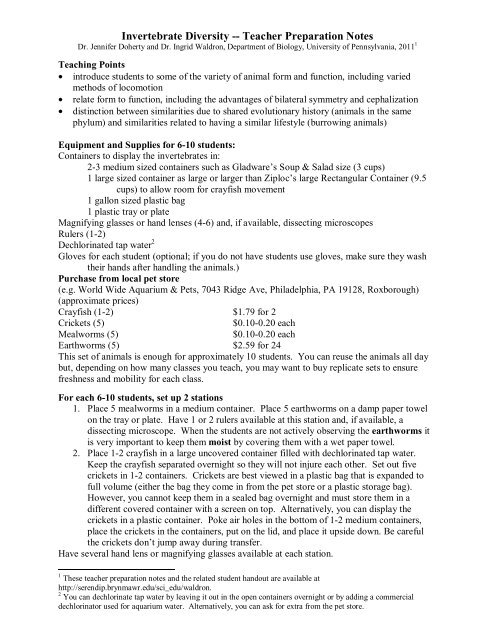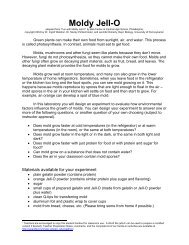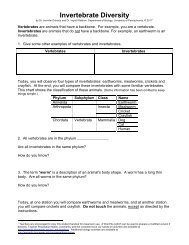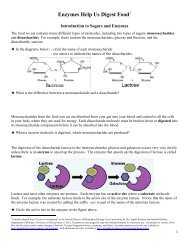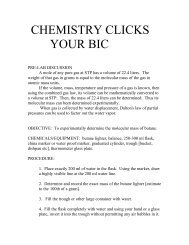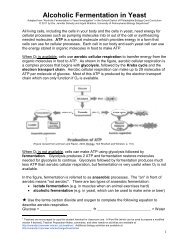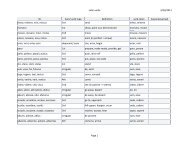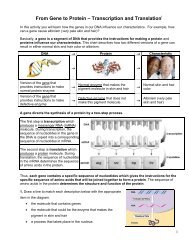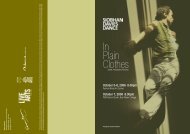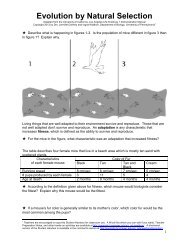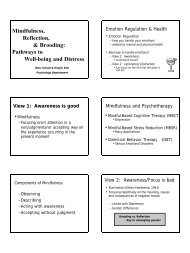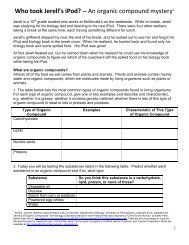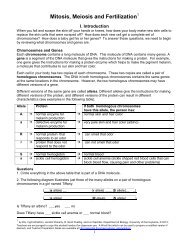Invertebrate Diversity -- Teacher Preparation Notes - Serendip
Invertebrate Diversity -- Teacher Preparation Notes - Serendip
Invertebrate Diversity -- Teacher Preparation Notes - Serendip
You also want an ePaper? Increase the reach of your titles
YUMPU automatically turns print PDFs into web optimized ePapers that Google loves.
<strong>Invertebrate</strong> <strong>Diversity</strong> -- <strong>Teacher</strong> <strong>Preparation</strong> <strong>Notes</strong>Dr. Jennifer Doherty and Dr. Ingrid Waldron, Department of Biology, University of Pennsylvania, 2011 1Teaching Points• introduce students to some of the variety of animal form and function, including variedmethods of locomotion• relate form to function, including the advantages of bilateral symmetry and cephalization• distinction between similarities due to shared evolutionary history (animals in the samephylum) and similarities related to having a similar lifestyle (burrowing animals)Equipment and Supplies for 6-10 students:Containers to display the invertebrates in:2-3 medium sized containers such as Gladware’s Soup & Salad size (3 cups)1 large sized container as large or larger than Ziploc’s large Rectangular Container (9.5cups) to allow room for crayfish movement1 gallon sized plastic bag1 plastic tray or plateMagnifying glasses or hand lenses (4-6) and, if available, dissecting microscopesRulers (1-2)Dechlorinated tap water 2Gloves for each student (optional; if you do not have students use gloves, make sure they washtheir hands after handling the animals.)Purchase from local pet store(e.g. World Wide Aquarium & Pets, 7043 Ridge Ave, Philadelphia, PA 19128, Roxborough)(approximate prices)Crayfish (1-2) $1.79 for 2Crickets (5)$0.10-0.20 eachMealworms (5)$0.10-0.20 eachEarthworms (5) $2.59 for 24This set of animals is enough for approximately 10 students. You can reuse the animals all daybut, depending on how many classes you teach, you may want to buy replicate sets to ensurefreshness and mobility for each class.For each 6-10 students, set up 2 stations1. Place 5 mealworms in a medium container. Place 5 earthworms on a damp paper towelon the tray or plate. Have 1 or 2 rulers available at this station and, if available, adissecting microscope. When the students are not actively observing the earthworms itis very important to keep them moist by covering them with a wet paper towel.2. Place 1-2 crayfish in a large uncovered container filled with dechlorinated tap water.Keep the crayfish separated overnight so they will not injure each other. Set out fivecrickets in 1-2 containers. Crickets are best viewed in a plastic bag that is expanded tofull volume (either the bag they come in from the pet store or a plastic storage bag).However, you cannot keep them in a sealed bag overnight and must store them in adifferent covered container with a screen on top. Alternatively, you can display thecrickets in a plastic container. Poke air holes in the bottom of 1-2 medium containers,place the crickets in the containers, put on the lid, and place it upside down. Be carefulthe crickets don’t jump away during transfer.Have several hand lens or magnifying glasses available at each station.1 These teacher preparation notes and the related student handout are available athttp://serendip.brynmawr.edu/sci_edu/waldron.2 You can dechlorinate tap water by leaving it out in the open containers overnight or by adding a commercialdechlorinator used for aquarium water. Alternatively, you can ask for extra from the pet store.
Teaching Suggestions and Biology BackgroundBefore beginning this activity, students should be familiar with basic concepts such as phylum,class, bilateral and radial symmetry. If you have a 40-50 minute lab period, you may want toplan to discuss the Follow-Up Questions in the next class period, so students will have plenty oftime to observe the animals.You may want to use the introductory section (page 1 of the student handout) as part of alecture/discussion for the class period before the lab activity. This could include an introductionto the annelid, arthropod and chordate phyla, as well as major subphyla like the Crustacea, andexamples of other animals included in these phyla, subphyla and classes.Characteristics of Observed <strong>Invertebrate</strong>sName Earthworm Mealworm Cricket CrayfishExternalanatomysegmentationvisible,clitellum*How doestheanimalmove?hydrostaticskeleton;alternatingshortening andelongation ofdifferentsegmentslegs, smallantennae, verysmall eyes,segmentationvisiblewalks on legson the front ofthe bodylegs, wings,eyes,antennae,segmentationvisible inabdomenlegs and wings(walking,jumping andflying)legs, claws(chelipeds),eyes, antennae,segmentationespecially visiblein abdomenswims backwardswith tail,walks forward onlegs*The clitellum secretes material that makes the cocoon which surrounds the eggs and fertilizing spermwhen they are released by the hermaphroditic earthworm after copulation.The following figure from Biology, 6 th Edition, by Campbell and Reece may be helpful forclarifying student observations concerning earthworm locomotion.
You can use the comparison between earthworms and mealworms to contrast phylogeneticcategories with non-phylogenetic common usage categories such as worms (animals with onedimension much longer than the other two). A phylogenetic category, such as a phylum, groupsanimals that share a common evolutionary ancestor and therefore share similarities in theirfundamental biology. Evolutionary relatedness is judged based on characteristics that often arenot obvious from the outside, so animals that have very different external appearance may begrouped in the same phylum (including larval forms such as mealworms and caterpillars whichare grouped with all other insects in the Arthropod phylum). In contrast, animals that looksimilar but have very different internal anatomy may be grouped in different phyla (e.g.flatworms, roundworms, and segmented worms).All of the animals in this activity are bilaterally symmetric. Bilaterally symmetric animalstypically have a concentration of sensory organs at the head end of the animal, which allows theanimal to gather information about the environment it is moving toward. (The concentration ofsensory organs and much of the nervous system at the head end is called cephalization.) Incontrast, radial symmetry is observed in organisms like jellyfish or hydra which drift slowlythrough the environment or are sessile; radial symmetry is associated with sensory organsdistributed around the circumference which receive sensory information from all directions.Follow-up Questions 3-6 guide students in thinking about similarities due to sharedevolutionary history vs. similarities due to adaptations to similar environments. If yourstudents have studied homology and analogy, you may want to link this discussion to homology(similarities due to shared evolutionary ancestors) and analogy (similar form for similar functiondue to convergent evolution). With regard to Follow-up Questions 4 and 5, both the worm shapeand the absence of substantial eyes are related to the burrowing lifestyle. Earthworms liveunderground and consume decaying organic material, and mealworms live surrounded by whatthey eat (e.g. grain or grain products).You may want to contrast the type of development in mealworms/Darkling beetles (completemetamorphosis) vs. in crickets (incomplete metamorphosis). Complete metamorphosis isobserved in insects where the larval stages look completely different from the adult (e.g.mealworms or caterpillars) and the transformation from the largest larva to adult occurs in apupa; the larval stages are specialized for eating and growing and the adult stage is specializedfor dispersal and reproduction. Incomplete metamorphosis is observed in insects like cricketswhere the young resemble the adults, although they lack wings; each molt produces a largerinsect with more nearly adult body proportions, and the final molt produces an insect with wingsand mature reproductive organs.For additional information on the anatomy, biology and care of these animals see the followingwebsites:Earthworm (e.g. Lumbricus terrestris)http://web.archive.org/web/20031209012204/http://www.icewatch.ca/english/wormwatch/resources/anatomy.htmlhttp://www.carolina.com/category/teacher+resources/care-guides/earthworms+and+redworms.doMealworm, larvae of Tenebrio molliterhttp://www.enchantedlearning.com/subjects/insects/beetles/mealworm/http://insected.arizona.edu/home.htm (click on “Using live insects in elementary classrooms”,then click on Information or Rearing sheets)http://www.carolina.com/category/teacher+resources/care-guides/mealworms.do
Cricket, Acheta domesticahttp://www.enchantedlearning.com/subjects/insects/orthoptera/Cricket.shtmlhttp://insected.arizona.edu/home.htmhttp://www.carolina.com/category/teacher+resources/care-guides/crickets.doCrayfish (e.g. Procambarus or Orconectes species)http://www.enchantedlearning.com/subjects/invertebrates/crustacean/Crayfishprintout.shtmlhttp://www.carolina.com/category/teacher+resources/care-guides/crayfish.dohttp://www.carolina.com/category/teacher+resources/classroom+activities/crayfish+in+the+classroom+article.doUnless you are very familiar with these organisms, we recommend that you have access to thesesources or an invertebrate zoology textbook during the activity to help you answer studentquestions. Also, the figures from these sources can help students to interpret observedcharacteristics.


